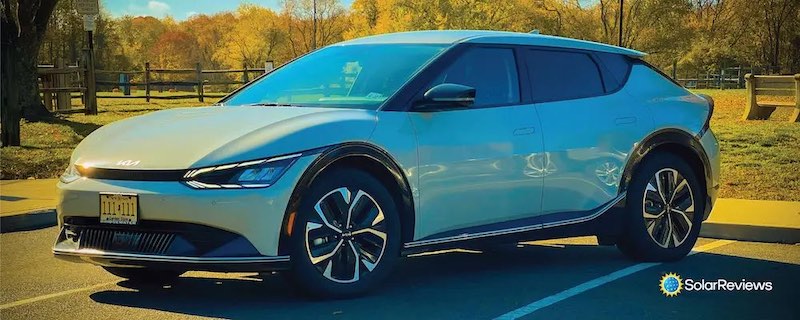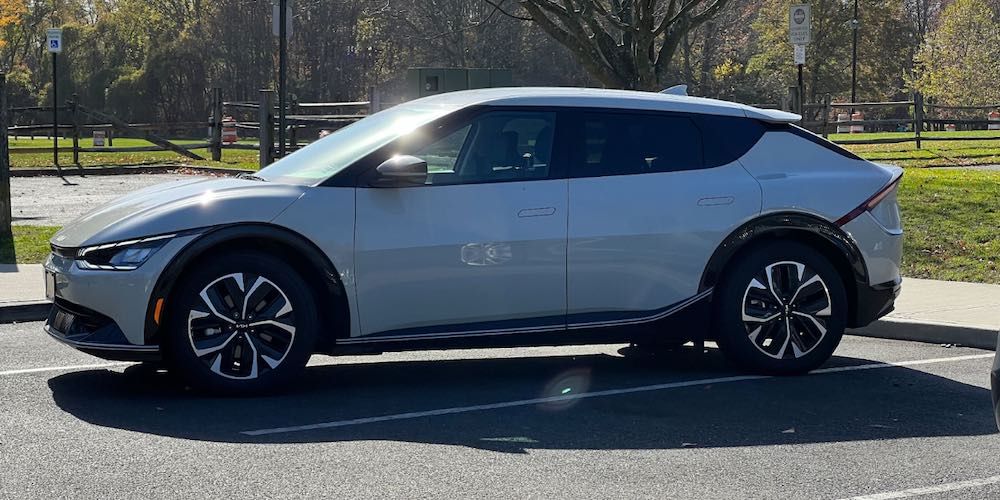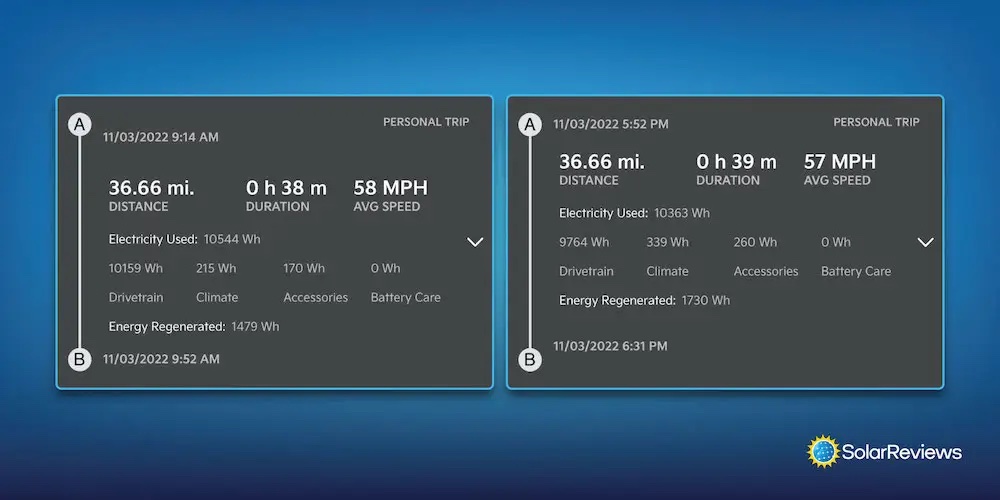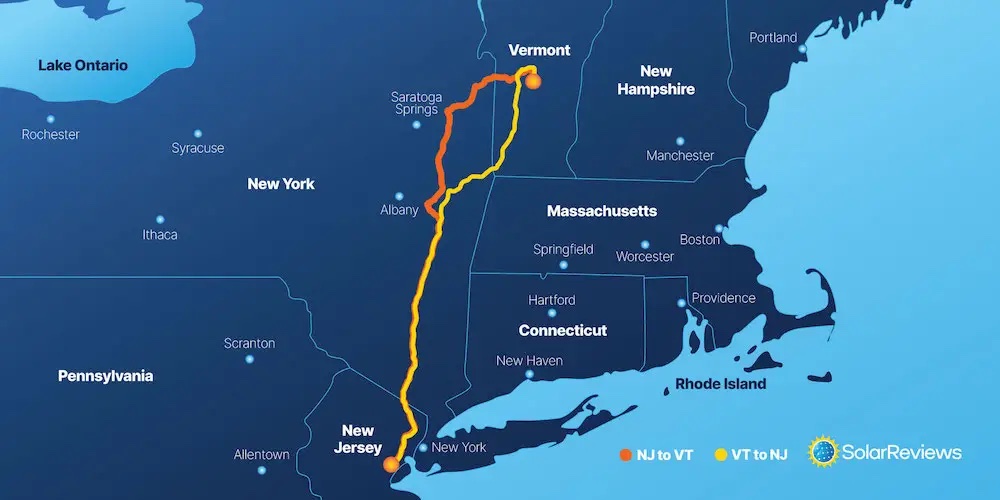Updated 11 months ago
We drove the Kia EV6: Here’s how it went
Written by
Ana Almerini

Find out what solar panels cost in your area
The Kia EV6 is a 5-person crossover all-electric SUV that seamlessly couples impressive luxury and sporty practicality. While the Kia EV6 is not the first or only EV offered by Kia, it’s a higher-end car than its other electric option, the Kia Niro.
The EV6 has a sleek look while remaining reasonably priced, so don’t be surprised when you start seeing more of them on the road. The team at SolarReviews got their hands on a Wind RWD Kia EV6 and put it to the test by not only taking it for a spin on a daily commute but also driving it across state lines.
Let’s take a closer look at what the Kia EV6 has to offer and what you should really expect as an owner of this new electric vehicle.
Overview of the Kia EV6
First, let's lay the groundwork of what exactly Kia’s all-electric SUV, the EV6, has to offer. The EV6 has MSRPs ranging from $41,400 to $56,400 depending on the trim level you choose. The Kia EV6 does not qualify for the federal EV tax credit under the current eligibility requirements.
The EV6 has cooled and heated seats and a display system that showcases how much electricity the car is using while driving, adaptive cruise control, and internal charging capability with a 120-volt outlet that can charge your laptop.
There are five trim levels available, each one offering its own set of unique features. There are three different models you can choose from: the EV6 Light, EV6 Wind, and EV6 GT Line. All models come with a 10-year/100,000-mile warranty, whichever comes first.
Trim option | Light RWD | Wind RWD | Wind (e-AWD) | GT-Line (RWD) | GT-Line (e-AWD) |
|---|---|---|---|---|---|
MSRP | $41,400 | $47,500 | $51,400 | $51,700 | $56,400 |
EPA-estimated driving range | 232 miles | 310 miles | 274 miles | 310 miles | 274 miles |
Battery size | 58 kWh | 77.4 kWh | 77.4 kWh | 77.4 kWh | 77.4 kWh |
Motor Torque | 258 lb. - ft. | 258 lb. - ft. | 446 lb. - ft. | 258 lb. - ft. | 446 lb. - ft. |
Horsepower | 167 hp | 225 hp | 320 hp | 225 hp | 320 hp |
The main difference between the trims, aside from aesthetic upgrades like a wide sunroof or automatically extending door handles, are things like horsepower and driving ranges. Additionally, the Light RWD has a smaller battery than all other Kia EV6 models, which keeps the price low, but means the car has a shorter range.
The EV6 seems to have a ton of great features, but is it a practical choice for everyday drivers?
What Kia EV6 model did we test drive?

We drove the Kia EV6 Wind RWD in the color Glacier, which has a 77.4 kilowatt-hour (kWh) battery and an EPA-estimated range of 310 miles. That works out to about 4 miles per kWh of charge. The Kia EV6’s already unique look combined with the Glacier color means you’ll never lose your car in a parking lot (and not just because the Kia Connect app has a car locator).
The EV6 gets points for the quality of the interior, too. All of the materials felt sturdy and of a higher quality compared to other EVs we’ve been in (sorry Tesla). Because EVs don’t need to include transmissions, the consoles between the seats have plenty of storage and make the car feel more spacious. The sheer quietness of the car while you're driving it is impressive, too – especially when you’re used to driving a 2011 gas guzzler.
One thing we weren’t so crazy about was trying to control the temperature while driving. You have to switch to another screen on the infotainment system if you don’t already have climate control up. Then, if you want to change a song or check how much time is left on your podcast, you have to go back to the media screen. There are some media controls on the steering wheel, but it was a little bit clunky to maneuver this all while driving.
How the Kia EV6 held up against a daily commute

Our daily commute is about 73.32 miles round trip daily and consists mostly of highway driving. Based on the specifications provided by Kia, this commute should use about 24% of the car’s battery.
How did the EV6 hold up in real life? Driving to and from the SolarReviews office used roughly 20.9 kWh of electricity, meaning the entire round-trip commute used about 28% of the energy stored within the battery.
So, actually driving the Kia EV6 on real roads with other drivers eats up more battery than how Kia tested it, making the actual range closer to 270 miles, not 310 miles, for our commute.
While it’s a little disappointing to see the range isn’t as high as advertised, that’s to be expected. Remember, even your gas car doesn’t get the exact MPG listed. Both the estimated range for an EV and the MPG for gas vehicles fluctuate depending on how you drive, the conditions of the road, and what you’re using in your car.
270 miles is still plenty of range, especially for commuting to and from work. We got to our office with no problem, and we still have more than enough battery life left to drive to and from work for the next two days without having to charge.
How long does it take to charge a Kia EV6 in real life?
We didn’t have to charge the EV6 after our drive to work, but we did anyway. We used a Level 1 charger that uses a typical home outlet and charges at 15 amps. Overnight, that brought our battery back up to a 95% charge.
This isn’t bad at all! Sure, it took eight hours to add about 25%, but all things considered, it didn’t cause us any inconvenience. However, sticking with a slow Level 1 charger probably wouldn’t cut it if we were using the Kia EV6 as our everyday vehicle. We’d probably invest in installing a Level 2 charger to fill the battery significantly faster, making the EV6 an even more practical option.

To truly test out the Kia EV6, we took it on a weekend trip from New Jersey to Vermont. On the way to Vermont, we made a pit stop at a cidery, for a total trip distance of 287 miles. Based on what we knew from driving the car to the office, we would be able to make most of the trip on one charge, but would probably have to top off at a charging station to get all the way there.
Charging stop 1
It took us about 2 hours and 45 minutes to drive from our house to the cidery, a total distance of 163.42 miles. This left us with about 53% battery charge. At that pace, we were actually getting 4.5 miles for every kilowatt-hour of energy used, which is higher than Kia’s EPA estimates!
But, we didn't want to run the risk of running out of battery, so we found a nearby EVgo charging station 2.5 miles away. The 50 kW charger was slower than some other charging stations, so we spent about 45 minutes at the station, getting us back up to about 80% charge before we hit the road.
This charging stop cost us $11.70. To add the equivalent amount of gas to a conventional SUV would have cost just under $17.
Charging stop 2
After the cidery detour, we continued on our way to our destination. After driving another 105.63 miles, we used 39% of the battery. We used a bit more energy per mile that we drove this time around, depleting the battery faster.
We decided to stop at a 150 kW public charging station in Rutland, Vermont just to be safe. This charger was much more powerful than the last public charger we used, so we only spent about 15 minutes at this stop, paying about $5.60, and getting our battery to 64% charge before the home stretch.
Reaching our destination
It took us just 26 minutes to get to our ski resort destination from the second public charging station. This brought us down to a 55% charge. We spent a total of four days at the resort, during which we didn’t take the car out or charge it at all.
Summarizing the drive to Vermont. Our almost 300-mile drive to the resort with the Kia EV6 wasn’t so bad. Charging ultimately added about an hour to our trip time that we would have avoided with a gas car, but we saved about $15.30 that we would have spent on gas. Overall, it wasn’t wildly inconvenient and we got there with no problem.
Charging stop 3
After our weekend getaway, it was time to head back to New Jersey. We drove about 15 miles back to the same EVgo station in Rutland, where we charged for 33 minutes. This got our battery to 90% full, costing us $11.55.
The car gave us an estimated range of 245 miles based on the 255-mile route to get home. Not to worry, 10 or so extra miles needed to be added on later in the trip, which should be quite simple at a rest stop.
Charging stop 4
The first attempt to get a quick charge was south of Albany, NY. The car’s navigation system brought us to a rest stop with one EV charger, but it was being used by another EV driver. We still had a decent amount of range left on our battery so we decided to skip the wait and kept driving to another rest stop 25 miles away.
Charging stop 5
Unfortunately, we hit another snag at this rest stop. The EV charger was broken. At this point, we were down to 44% on our battery. Enough to get us to a different charging station, but not enough to get us home.
Charging stop 6
The next choice was an outlet store with public charging stations 60 miles away. Yet, the EV charging spots were parked in by cars that weren’t even charging.
For those keeping track, the car has about 14% battery left at this point.
Charging stop 7
There was an open charger listed at a nearby Mercedes-Benz dealership, but it could only be used by Mercedes owners. At this point, we were falling below the 10% charge left on our battery.
We decided to download the individual charging station apps for EVgo, ChargePoint, and EVconnect instead of just relying on Kia’s built-in map of chargers, hoping for better luck.
Charging stop 8
Finally, EVgo brought us to an open, working charging station with just about 1% charge left on the battery. Three more miles and we would have been stranded.
Because we were so close to home, we didn’t have to charge for long. We stayed for 20 minutes, adding 14.4 kWh to our battery, enough charge to get us home in one piece. This charge cost us roughly $7.00.
Home sweet home
We used 7.5 kWh to get from the final charging station back into our garage. Then, we plugged the EV6 in with our Level 1 charger so it could charge overnight to get us back to the SolarReviews office on Monday.
Charging isn’t as easy as plugging in your car. The drive home wasn’t nearly as smooth as the drive there. We stopped four separate times at stations that didn’t have available chargers and ended up adding an additional 2 hours onto our trip. Maybe waiting for the first EV station to become available was the best way to go, but hindsight is 20/20. This trip clearly showed that EV infrastructure (and human courtesy) is not as strong as it needs to be for mass EV adoption for long-distance travel.
So, what is the final say on the Kia EV6?
Moral of the story: the Kia EV6 is great for commuting to work and running simple errands when you have a charger at home. Considering this is what most U.S. drivers use their cars for, the Kia EV6 is definitely worth considering. It’s not as expensive as luxury EVs on the market but still offers impressive specs.
Long-distance travel on the other hand? We’re not so sure the U.S. charging infrastructure is quite ready for widespread EV road trips. Our drive to Vermont wasn’t too bad, but the drive home was just shy of disaster. Sure, we saved on gas, but we gave ourselves a headache and added 2 hours to our trip trying to navigate to a working available charging station. In the future, we would do a little more pre-planning for our route to make the charging situation a little less stressful.
But, if you’re in the market for a new car and you’re not frequently driving over 250 miles at a time, the Kia EV6 is worth considering. Even if you do take the occasional weekend trip, you can avoid most problems by pre-planning your route. The EV6 is sleek, modern, and reliable. Plus, it’s green and keeps more money in your wallet by avoiding high prices at the gas pump. If an EV is your next pick, you should consider installing solar panels at the same time to maximize your EV savings and charge your car almost for free!
Ana is the Marketing & Communications Manager at SolarReviews, working within the solar industry since 2020. With a Master's in Climate and Society and professional experience in marketing, she helps communicate the value of solar to homeowners and build awareness of the SolarReviews brand. On weekends you can find her at the Jersey shore, reading a book from the ever-increasing stack on her side table, or eating food someone else cooked....
Learn more about Ana Almerini